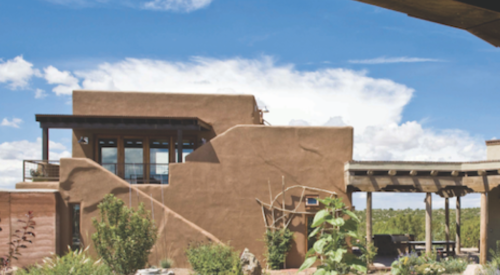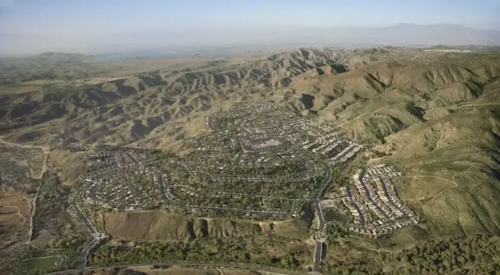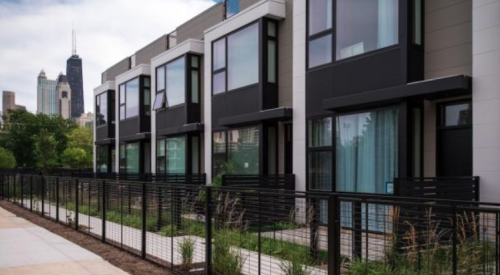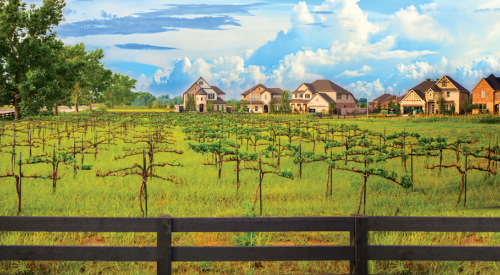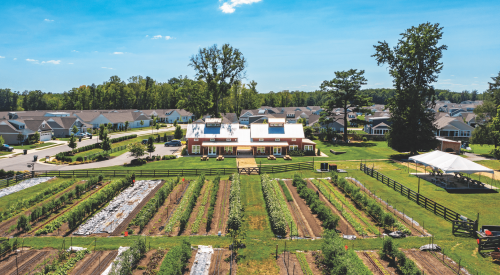Some are old and some are just beginning, but no matter what stage they’re at, the communities, the builders and the developers profiled here are the ones writing a new set of rules for residential development. To them, sustainable and development aren’t mutually exclusive, but rather words that when married together, are greater than either is alone.
Hidden Springs
| Hidden Springs, enviably situated amidst Idaho’s Boise Front foothills, offers residents dramatic, unobstructed views of nature-hills, valleys, sunrises and sunsets. Residents also can connect easily with the natural environment on 100 miles of walking and biking trails.
|
A common thread that runs through most discussions about sustainability, transit-oriented villages, new urbanism and pedestrian-oriented neighborhoods is the ability to change people’s isolationist behavior by modifying the environment.
"A developer can’t create a community, but in planning and providing amenities, we can set the tone and facilitate people’s coming together and taking a sense of ownership of the environment," observes Frank A. Martin, president of Hidden Springs, a master-planned community outside Boise, Idaho.
Setting the right tone is what the developer, Hidden Springs LLC, a partnership between the Grossman Family Properties, Boise, and the Carlyle Group, Washington, D.C., has done skillfully at its 1844-acre development. The community’s café, general store and post office have evolved as central gathering places.
On any given day in Hidden Springs, people buy produce grown on the land. Kids skate around the post office and pick out candy at the general store. Friends meet in the café, and a home-based business owner drops off overnight mail at the post office.
Simple things like a mail service that delivers to a central spot rather than to individual houses create opportunities for Hidden Springs residents to catch up on the day’s news and get to know one another in a casual way, not unlike the way socializing was done half a century ago.
Marrying Development and Nature
Hidden Springs is enviably situated 20 minutes outside Boise in Ada County in a spectacular environment - the Dry Creek Valley, which is part of the Boise Front Foothills. The unobstructed views from the development offer sunrises and sunsets and the rugged hills and valleys carved out by nature. The development is built around a 100-acre working farm, first established in the 1860s, which still produces 60 varieties of fruits and vegetables that are sold at Hidden Springs’ general store and farmer’s market. More than 800 acres will remain as protected open space, and residents can walk from their backyards directly into nature to reach more than 100 miles of hiking and biking trails.
In establishing the founding vision for Hidden Springs, the developer took some of its cues from the land. Included among the principles are creating a rural character; respecting and cherishing the natural environment; and designing and building traditional homes that use resources and energy efficiently.
| The community cafe, general store and post office in the 1844-acre development are resident gathering spaces.
|
What emerged from those founding visions was a development composed of three distinct neighborhoods that provide a sense of small-town, rural living in a way that embraces principles of sustainability, as well as aspects of pedestrian-oriented villages.
The housing product is diverse and ranges from in-town homes to custom homes on one and one-half-acre sites. Each neighborhood is governed by comprehensive design guidelines that cover site planning, architecture and landscaping:
The first phase of the development comprised 140 homes - 92 in the Village, 30 in the Foothills and 18 in the Valley. Affordability, often an elusive goal in such master-planned communities, has been addressed by a zoning provision that allows for the construction of an accessory unit - a granny flat - that can be rented out. In addition, in a future phase the developer is introducing an attached single-family property, not a townhouse, but a two-family home that looks like a single-family property.
The traditional architecture at Hidden Springs doesn’t mean the houses aren’t without modern conveniences and comforts. Each home has access to three telephone outlets and three cable television outlets, as well as high speed Internet access via a DSL line.
Energy Innovations
Martin says Hidden Springs is the first community in the Northwest developed in conjunction with the U.S. Department of Energy’s Building America program. The houses were constructed for maximum comfort and energy savings. Among the energy saving techniques employed include R-26-rated, 226 exterior walls with R-21 insulation, foundation insulation blankets, high-efficiency 50-gallon gas water heaters, water-conserving aerators on all faucets and shower heads and low-E, argon-filled glazing on windows.
In addition, the development employs an innovative wastewater reclamation system that biologically treats water - through heavy aeration - so successfully that after 36 days it can be reintroduced to irrigate the farm and common areas.
Thus far, the energy standards and construction techniques adopted in the first phase have yielded overall energy savings of one-third over traditional developments. Martin says residents are saving approximately 40% on heating and 35% on cooling costs.
The development saw its first 33 families take occupancy late last summer, and site development for the second phase of Hidden Springs - 128 homesites - is now underway. Future phases, Martin says, are largely dependent on market conditions.
Coffee Creek
| The plan for Coffee Creek Center involves a variety of home types for an economically-mixed population in a compact, pedestrian-oriented neighborhood. The 640-acre development just 40 miles southeast of Chicago will include commercial and retail space as well.
|
It’s one of the reasons that a 160-acre greenspace with gathering spots like a gazebo and amphitheater, as well as a series of neighborhood parks, are being incorporated into the Coffee Creek Center, a 640-acre residential and commercial development located about 40 miles southeast of Chicago. When it makes its debut, the development will provide a wide variety of home types for an economically-mixed population in a compact, pedestrian-oriented neighborhood that includes residential, retail and work space. The development will peacefully co-exist with restored native ecosystems and habitats.
Perpetual Green
The green space serves as the development’s centerpiece and, if the planners have their way, it will stay that way forever. In fact, LEL thinks open space is so critical that it has executed some legal maneuvering to ensure its vision. LEL created environmental guidelines, legally described the conservation district and what it should entail and then deeded it to a non-profit group that is bound by those guidelines. The Coffee Creek Center’s property owners association will financially support the non-profit venture, but the conservation group will be in charge of the land for the long haul.
| Coffee Creek developers are restoring creek banks throughout the property and putting in place guidelines for a conservation district.
|
The housing plan for Coffee Creek includes a series of neighborhoods, including Morgan’s Corner and Village Green, and the first phase of the development - approximately 192 apartments and 212 single-family houses - is getting underway. Initial occupancy is anticipated next spring. The apartments include one and two-bedroom units, with rents ranging from $800 to $1200. The single-family homes include attached townhouses and cottage, village and estate homes priced between $120,000 and $275,000 and up. An outpatient, community health care center is also under construction, and LEL anticipates a deal with a hotel.
Scientific Approach
LEL is consulting with environmentalists and a building sciences company to uncover potential conservation opportunities and make sounder design, equipment and construction decisions. They’re studying everything from window and duct locations to minimizing construction inefficiencies.
The following are among the approaches LEL is exploring and adopting:
| The developers of Coffee Creek tapped top environmentalists to help them reclaim the natural ecosystem that existed on the site prior to settlement.
|
For instance, a grocer could create flexible quasi-storefronts that face the street within its space to house its bakery and deli. If the business changes, those spaces could be adapted to a different use for the grocer or it could lease them out to smaller shops and gain an extra income stream. "If a store has, let’s say a 10-year lifespan, you don’t want to have this unwieldy box sitting there that can’t adapt to a new tenant or a different use," comments Warren.
In addition, LEL is looking at parking issues for a big-box. Despite its commitment to a pedestrian-oriented village, LEL doesn’t want to outlaw parking because it realizes that not everyone always wants to walk to the store. Whatever parking there is will be smaller - either in the back of the store or on the street - than what is customary in traditional developments.
Future phases include additional residential units and a 212-acre mixed-use downtown district. The development is a 15- to 20-year project, and the timing and components of future phases depend on how quickly the proceeding one is absorbed.
Warren is confident that there’s a market for a development like Coffee Creek. He points to the surge of interest among prospective buyers that was generated by a short article and rendering that ran in the Chicago Tribune real estate section before anything even existed at the site.
Moreover, LEL senses that people feel a deep dissatisfaction with existing suburbs and that they are ready to do an about-face - leaving behind excessive privacy and physical isolation in favor of a true sense of community in a place where they can get physically and emotionally close to neighbors.
"People really do seem to want what they think they’re afraid of," says Warren. When he describes the development - tight setbacks, alleys, higher densities and smaller lots - people say, "I’m not sure I’m interested." Then, when he shows them pictures and renderings, people tend to swoon a bit and respond, "My grandma lived in a place like this. I love neighborhoods like that."
Erie-Ellington Homes
| The Erie-Ellington Homes, Boston, demonstrates how urban, affordable housing can be built in an environmentally sustainable way and cost less than traditional approaches.
|
The project comprises 50 multifamily, duplex and triplex homes in an urban infill project scattered on seven sites over 3.5 acres in the Codman Square Neighborhood in the city’s Dorchester section. Once a vibrant residential and mixed-use area, the neighborhood declined during the 1960s and 1970s, and the project is part of a citywide strategy to bring friendly, low-rise, low-income housing to Boston. The housing units offer residents between one and four bedrooms, with monthly rental rates ranging from $288 to $1044.
The Erie-Ellington Home project is breaking new ground in environmentally sustainable building circles as well. "This is an early project that proves environmental sustainability and affordability are not incompatible," says Stella Tarnay, director of outreach for Cambridge, Mass.-based GreenVillage Company and Hickory Consortium.
Erie-Ellington Homes was designed by architect Bruce Hampton and engineer Mark Kelley, both of the GreenVillage Company. GreenVillage and its research division, the Hickory Consortium, are participants in the U.S. Department Of Energy Building America Program. Other project partners include developers Codman Square Neighborhood Development Corporation and the City of Boston Department of Neighborhood Development; CWC Builders Inc., Newton, Mass., and Thomas Construction Co., Inc., Dorchester, Mass., joint venture contractors for the project.
Systems Savings
Key to the project’s success is the holistic, systems-based approach the team devised to design and build the homes. They considered all aspects of the project - the site, mechanicals, landscaping, windows, finishes and so forth - and determined how the design and engineering of one component affects the others.
Kelley, of the Hickory Consortium, says the design and engineering team started by working from the outside in, examining how the building exterior affects environmental sustainability and energy use, and how those effects could be adjusted by changing the envelope. Inside, they looked at things like water usage, heating issues and systems requirements.
Ultimately, the team designed an extremely tight building, featuring R-30 insulation in roofs and R-11 in basement walls and crawl spaces, and double-pane, low-E windows with argon fill. The tight envelope had a ripple effect, reducing heating loads, which, in turn, reduced equipment requirements. "Normally a three-family building would have three boilers and three water heaters. We found that we could reduce it to one boiler," says Kelley. "We saved close to $10,000 in equipment costs in each building," he adds. Such savings helped justify the added expenses - high-efficiency windows, for instance - associated with boosting the performance of the buildings’ envelopes.
| A typical triplex unit of the Erie-Ellington Homes, Boston, includes two 1042-square-foot, two-bedroom units and one 724-square-foot unit.
|
The building interiors were also places where dramatic economies were realized. The team found that residents living in other low-income properties were spending $700 in water, plus water heating costs. Specifying low-flow toilets, faucets and showerheads slashed water usage and, by opting for high-efficiency fluorescent lights and appliances, such as dishwashers and refrigerators, the project was eligible for significant rebates through the U.S. Environmental Protection Agency’s Energy Star rebate program.
Measured against the Model Energy Code, the project achieved dramatic reductions in energy use, operations expenses and construction costs.
Health Gains
Energy and economics, of course, weren’t the only yardsticks of success. Ecology and health issues, too, played essential roles. Products and finishes were subjected to a litmus test before they were specified. Among the questions: Are they damaging to the planet? Are they sustainable? For instance, more traditional options like vinyl or cedar to sheath the buildings were vetoed. Vinyl, explains Kelley, creates pollution during its manufacture and the designers had concerns about its flammability and long-term durability. Cedar was ruled out due to apprehensions about the depletion of cedar forests. The best option ended up being cement board for its long-term stability.
For interior finishes, pains were taken to ensure a healthy environment and to help minimize childhood asthma and respiratory illnesses, the occurrences of which have spiked in Boston’s inner city neighborhoods. Natural linoleum was chosen for the common areas of the buildings, and low VOC carpets and zero VOC paints all contribute to better indoor air quality. In addition, an automatic ventilation system draws fresh air throughout the buildings.
Beyond all the environmental aspects of the project, Erie-Ellington Homes advances low-income housing on another front: Its appearance represents a dramatic departure from the grim aesthetic typically associated with affordable housing. The design successfully incorporates characteristics typical of traditional New England homes - porches, bay windows and gabled roofs - and exterior hues like greens, roses and yellows bring a refreshing cheerfulness to a neighborhood that is well on its way to a renaissance.
"Everyone who visits takes a deep breath and says, ‘These are so nice," comments Tarnay, and asks, "‘These are affordable?’"
Prairie Crossing
<| Prairie Crossing developers have married traditional achitecture with the site’s natural elements - fields, marshes and prairie.
|
Ranney is vice president of Prairie Holdings Corporation and one of the visionaries who brought about one of the early, much-publicized and much-studied conservation communities, Prairie Crossing, in Grayslake, Ill., a Chicago suburb.
"Don’t do a knock-off of Prairie Crossing or another development," adds Ranney. "Take the sustainable principles and build what’s right for the place - something reflective of your vernacular architecture and with a tradition of place. It will be a commercial success."
Prairie Crossing stands as a semi-grown-up example of what the sustainable developments under construction today can become. The development, although not compete, debuted about five years ago and has evolved and grown in that time. The 667-acre site will eventually be home to a total of 362 houses; about 180 have already been constructed.
Today Prairie Crossing is a community that illustrates how principles of new urbanism and conservation can be compatible, and proves that the old traditions of face-to-face contact with neighbors and letting the land enhance people’s lives can be a reality.
Prairie Crossing offers 12 different homes on four different settings, ranging from 1200 to 3500 square feet
Rather than driving away creatures like egrets, herons and frogs as other developments do in the suburban sprawl that has engulfed the suburbs surrounding Prairie Crossing, the community provides a preserve for them by retaining their natural habitats.
Glancing Back
Prairie Crossing is based on 10 guiding principles, including environmental protection and enhancement; a sense of place; economic and racial diversity; lifelong learning; and convenient, efficient transportation. Residents review these principles annually to see how closely the community is adhering to them.
A quick scan of Prairie Crossing photos demonstrates that the development has done exceedingly well at protecting the environment and creating a sense of place. The rolling countryside, prairies, farm fields and marshes dotted with houses featuring gabled roofs, wraparound porches, transom windows and lines reminiscent of Midwestern farmhouses could be an image on a postcard. An organic farm provides fresh produce, and the community’s center is an 1890s barn, the Byron Colby Barn, saved from demolition and reconstructed on the site. It’s a place for town meetings, lectures and community parties.
With home prices ranging from $200,000 to $500,000, the goal of economic diversity has proved more elusive. Prairie Crossing recently attempted to include more affordable granny flats in the development’s next phase - a transit-oriented neighborhood in the southern section of the site and situated around a proposed train stop.
"We would have liked to provide homes under $200,000, but we were turned down by the village board," comments Ranney. Instead, 45 new homes will be built that will further the community’s vision for energy efficiency. People will be able to walk from home to the train, get off in Chicago, walk to their offices, and return home without removing the car from the garage. "Life is much more pleasant when you can walk and see people, rather than getting in the car for everything in life," says Ranney.
The community’s goal of building energy efficient housing has been satisfied, as well. Homes incorporate many energy-saving features standard in today’s sustainable developments, including high-performance glazing on windows, interior air flow retarders and walls with 226 advance framing and R-19 batts. The systems design and construction approaches have yielded a 50% higher energy efficiency rating compared to conventionally built houses.
Mixing Traditions
| Prairie Crossing was one of the earliest developments to incorporate sustainable principles in its design. About 180 homes have been built in the 667-acre community to date.
|
The homeowners association does annual prairie burns (the burns kill weeds and stimulate new growth) and teaches residents proper burn techniques. It’s an old communal rural tradition, not unlike barn-raising. After burn school, people got together in small groups to help each other burn individual yards. Later, over the community e-mail system, residents wrote about the burns and thanked neighbors for their help with the burns. "It’s the long tradition of neighbor helping neighbor, but the discussion takes place on a 21st century convention - e-mail," says Ranney.
Civano
| The 20,000 sq. ft. commercial center at Civano is virtually leased up.
|
The three-point Civano mission statement seems straightforward, but executing it and adhering to it is no simple task:
Over the next seven years, the grand plan is to construct 2600 homes, as well as recreation, retail and workplaces in a way that incorporates cutting-edge technologies like solar energy, water harvesting and straw bale construction.
| Over the next seven years, the community will grow to include 2600 homes as well as recreation, retail and workplaces.
|
Look Back
Rayburn runs through a short list of goals, some of which are based on the City of Tucson’s IMPACT system, and rates the initial development’s performance:
Among the more intangible measures of success is the fact that people are out walking, sitting on porches and using the amenities, and the faces in the community are those of little kids, middle-aged empty-nesters and senior citizens, rather than a homogenous group. Rayburn says interest in the community has been strong and that prospective buyers are particularly attracted to the neighborhood’s look and feel, as well as the connectivity and community that comes with the development.
The other strong selling point is values - the fact that the development speaks to people’s personal values about minimizing the drain they place, as well as the lighter load living in Civano places on their wallets because of smaller utility bills. "To me, the proof in the pudding is that homebuyers are adding upgrades, which is indicative that they think this is their home and this is where they’re staying," says Rayburn.
